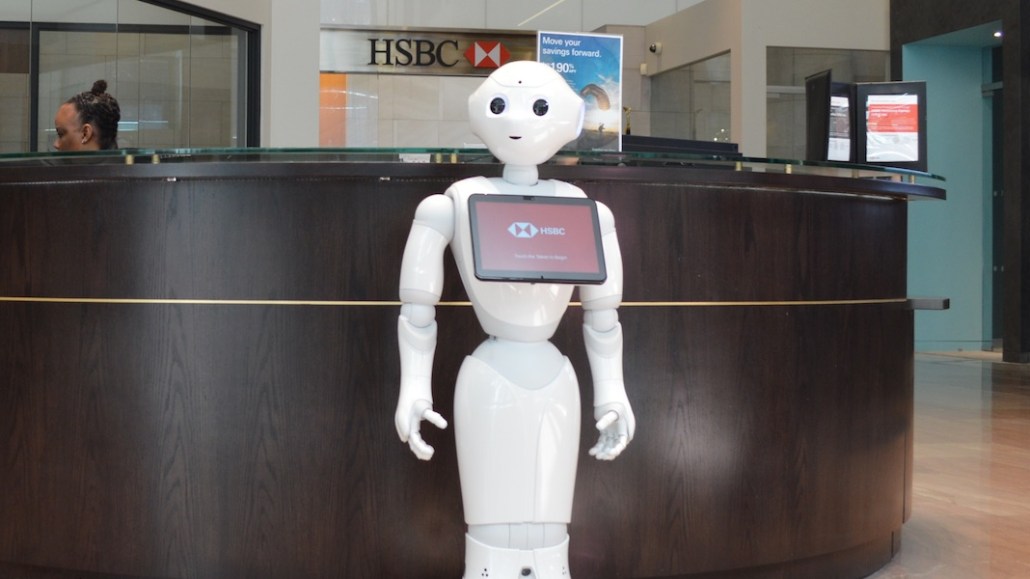Register by Jan 13 to save on passes and connect with marketers from Uber, Bose and more
HSBC is using a blinking, humanoid robot to add the ‘human touch’ to banking

Customers visiting HSBC’s flagship New York City location on Fifth Avenue will now be greeted by a robotic employee called Pepper upon arrival.
But while Pepper can help with simple questions and greetings, it’s not about to take over tellers’ jobs quite just yet. It’s actually being deployed to make the banking experience more human, ironically with a robot.
“The death of the branch has been touted for the past 10 years, but what we find is the branch is still one of the most important reasons people choose a financial institution,” said Pablo Sanchez, regional head of retail banking and wealth management for the bank’s U.S. and Canada operations. “[Pepper] educates and gives people awareness of other ways to transact or to get human interaction — we don’t want to lose the human touch.”
With the growth of digital banking, the industry has been grappling with what to do with physical branch spaces. Branches are becoming less transaction-focused and increasingly turning into relationship centers, or anchors for human-centered banking experiences. While Pepper is a robot, it acts as a concierge that can direct customers to bankers who can help them. It can answer simple questions, and doubles as an online banking station, with a tablet screen where customers can get more information about products, log into their mobile banking account, or just “have fun” by taking selfies or dancing with the robot.
HSBC is testing Pepper at its flagship New York City location, but isn’t saying more right now about plans to deploy it further. The bank is focusing on getting customers comfortable interacting with it.
“What we expect from Pepper is not to replace humans, but to actually build the business so that we can hire more people here at 452 [Fifth Ave.] and across our network [and] help customers fulfill their financial needs,” he said.
Adding robotic employees will let bankers focus on more complex tasks, said Aite senior analyst Tiffani Montez.
“It’s looking at the things a consumer does in a branch and focuses on using technology to take the non-value-added activities [away from bankers], allowing employees to focus more on truly building relationships,” she said.
Since robots are already being deployed in retail locations — for example, Lowes’ LoweBot can find products and navigate inventory throughout the stores — it’s natural to expect customers to demand similar types of service offerings from their financial institutions, she added.
Pepper was developed in 2014 by Softbank Robotics. It’s designed to mimic a human with inbuilt abilities to recognize the presence of humans and their emotions. It has the ability to capture customer-specific data including names and appearances. While bankers and retailers may find this useful, HSBC said it has no plans to roll out that capability right now.
Despite Pepper’s potential as an engagement and task efficiency tool for bankers, it also has its limitations. At this point in its evolution, Pepper still needs to escalate complicated questions to humans, and unlike Amelia — the robotic “cognitive agent” used by some banks and insurers developed by software company IPsoft — it’s unable to think on its feet and must be trained in advance.
“The Pepper platform isn’t very rich in terms of integration,” said J.P. Gownder, principal analyst at Forrester. “Most of the deployments haven’t been very sophisticated; it’s mostly about finding out ‘where do I go in the store’ and answering very simple questions.”
What would give Pepper the muscle to go beyond a novel engagement tool, said Gownder, would be to add more “thinking” capabilities like natural-language understanding. For now, its effectiveness doesn’t go beyond being a “way finder” — an engagement tool that helps customers navigate and reach humans when they require more assistance. It could have a positive effect of drawing people in the branch and generating excitement about the customer journey, but it could backfire if it’s not seen to be adding value to the experience.
“If Pepper’s artificial intelligence is sufficient, it may even be helpful in helping guiding the consumer’s retail experience,” said Gene Pranger, CEO of POPin, a company that helps financial institutions with customer service technology solutions for brick-and-mortar branches.”If, however, the first experience is simply novel and doesn’t serve the interest of the consumer on an ongoing basis, the technology will quickly fade into oblivion.”
More in Marketing

What does media spend look like for 2026? It could be worse — and it might be
Forecasts for 2026 media spend range from 6.6% on the lower end to over 10% but the primary beneficiaries will be commerce, social and search.

Pitch deck: How Amazon is emerging as the proof layer for TV spend
Amazon is positioning itself to advertisers as the “first-stop shop” for planning, buying, optimizing and measuring TV.

Here are the 2025 brand winners and losers of tariffs
Tariffs completely upended the retail industry in 2025 — and no company was left unscathed.





